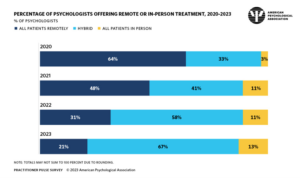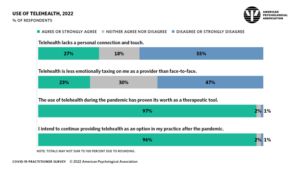Post-Pandemic Telehealth Practices Among Psychologists
Despite decades of research supporting its effectiveness [1], only 21% of psychologists reported using telehealth within their practice before the COVID-19 pandemic [2]. This all changed practically overnight, as the use of telehealth increased 12-fold to about 86% during the pandemic [3]. The necessary and rapid adoption of telehealth during the pandemic was facilitated, in large part, by significant US policy changes including the Centers for Medicare and Medicaid Services (CMS) relaxing reimbursement restrictions and the originating site requirement [4] (U.S. CMS, 2020). Telehealth clearly played a critical role early in the pandemic to maintain continuity of care and increase access by removing traditional barriers to receiving care such as transportation. But what is the current state of telehealth for psychologists several years after the start of the pandemic?
SURVEYING PRACTITIONERS
Since 2020, the American Psychological Association (APA), has been conducting an annual Practitioner Survey with a sample population of doctoral-level licensed psychologists in the United States who provide direct patient care.
The goal of these annual surveys is to assess practice patterns, including the use of and attitudes toward telehealth since the start of the pandemic. APA’s Practitioner Surveys are distributed via email to a random sample of licensed psychologists during the fall of each year. For more information on the methodology of these annual surveys, please see Lin et al. (2022) [5].
MOST PSYCHOLOGISTS MAINTAIN HYBRID OR FULLY REMOTE PRACTICES
While 88% of respondents reported either working in a hybrid in-person and remote practice or a fully remote practice, psychologists are shifting back toward more in-person services (Figure 1). The use of fully remote practices has been on a downward trend since its height in 2020 at 80% of all reported practices to its 2023 level of 21%. The decline in fully remote practices each year has taken place alongside an increase in the number of psychologists seeing patients both in-person and remotely (hybrid). The overall trend of the last four years has been a slow return to providing some in-person services, with most respondents maintaining some level of remote service provision.

PSYCHOLOGISTS ATTITUDES TOWARD TELEHEALTH
While 55% of psychologists disagreed with the statement that telehealth lacks a personal connection and touch, 27% agreed with it (Figure 2). Almost half of psychologists (47%) did not agree that telehealth is less emotionally taxing on them than face-to-face, but 23% thought that telehealth is less taxing than in-person. Despite these differences, virtually all psychologists (96%) said they believed the use of telehealth during the pandemic has proven its worth as a therapeutic tool, and the same proportion intend to continue to provide telehealth services moving forward.

The present and future of mental and behavioral health service delivery has been forever changed. Psychologists have shown themselves to be adaptable, changing their work habits during the pandemic to include fully remote or hybrid practices. Although the most recent APA Practitioner Survey showed a small shift back toward seeing some patients in-person this year, the majority of psychologists maintain hybrid practices and see significant value in telehealth in their practices.
It is worth noting, however, payment/reimbursement issues, cross-jurisdictional issues, and patient access to technology were cited as top challenges to continuing telehealth after the pandemic. Patient demand for telehealth mental health services is likely to continue and payor and policymakers have important decisions to make regarding the future health care landscape. Allowing flexibility in policies, regulations, and format of mental and behavioral health service delivery is key to addressing population health and health equity in the United States.
ABOUT APA
APA is the largest scientific and professional organization representing psychology in the United States, with a membership of over 157,000 clinicians, researchers, educators, consultants, and students. APA seeks to promote the advancement, communication, and application of psychological science and knowledge to benefit society and improve lives
[1] Backhaus, A., Agha, Z., Maglione, M. L., Repp, A., Ross, B., Zuest, D., . . .Thorp, S. R. (2012). Videoconferencing psychotherapy: A systematic review. Psychological Services, 9, 111–131. http://dx.doi.org/10.1037/a0027924
[2] Pierce, B. S., Perrin, P. B., & McDonald, S. D. (2020). Demographic, Organizational, and Clinical Practice Predictors of U.S. Psychologists’ Use of Telepsychology. Professional Psychology: Research and Practice, 51, 184-193. http://dx.doi.org/10.1037/pro0000267
[3] Pierce, B. S., Perrin, P. B., Tyler, C. M., McKee, G. B., & Watson, J. D. (2021). The COVID-19 telepsychology revolution: A national study of pandemic-based changes in U.S. mental health care delivery. American Psychologist, 76, 14-25.
[4] U.S. Centers for Medicare and Medicaid Services. (2020). Medicare tele-medicine health care provider fact sheet. https://www.cms.gov/newsroom/fact-sheets/medicare-telemedicine-health-care-provider-fact-sheet
[5] Lin, L., Stamm, K. E., Ferenz, K., Wright, C. V., Bethune, S., & Conroy, J. (2022). Relationship between challenges with the use of telehealth and psychologists’ response during the coronavirus pandemic. Professional Psychology: Research and Practice, 53, 596-605. https://doi.org/10.1037/pro0000481

